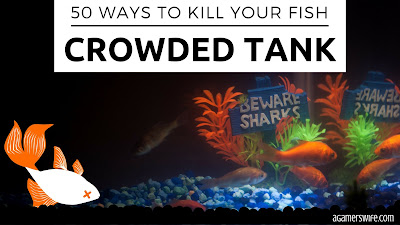If you post an online picture of a beautiful hobbyist-owned aquarium packed full of fish, you'll probably get several reactions:
- OMG, that is the coolest thing I've ever seen! (^▽^)
- OMG, that is the cruelest thing I've ever seen! ((╬◣﹏◢))
- OMG, how did they accomplish that? I must know! ლ(ಠ_ಠ ლ)
 |
| Clearly, five cats is not enough. You need at least six in a school or else they start getting nippy. |
Huge props to the Real Fish Talk: How Much Is Too Much? video for breaking it down like this:
The more fish you have,In other words, more fish = more time you'll have to invest to maintain them and keep them healthy. My idea of fun is enjoying my fish without having to change their water more than once a week, so if that's not achievable, I probably have too many fish or something else needs to change. (I'm not lazy; I'm just low maintenance...) For example, I once tried to keep two axolotls in a 20-gallon tank, which was fine when they were juveniles. However, the larger they got, I found myself doing daily water changes to keep up with the huge waste load. (No one told me these things lay giant doggy turds!) Clearly, I had one too many axolotls in that tank and I was no longer enjoying my hobby as much as I wanted.
The more food they eat,
The more waste they create,
The more work you have to do to keep the tank clean.
 |
| "Welcome back to Survivors: Axolotl Edition! Who will get voted off the island in this episode?" |
When it comes to deciding how many fish are going into an aquarium, I like to plan rather than impulse buy. The AqAdvisor aquarium stocking calculator is a nice starting point for beginners. You enter your tank size, filter brand, and a list of fish, and the website spits out recommendations on compatibility and how "full" your tank is. Then you slowly start adding fish and regularly test the tank water every few days to see how clean it stays over time. (For freshwater parameters, people usually like to see 0 ppm in ammonia and nitrites and maybe 40 ppm or less of nitrates.)
Case in point: here's the step-by-step plan of action for building my community tank 3.0:
- Research different combinations on fish and stocking levels using caresheets and AqAdvisor.
- Set up and cycle my display tank with live plants and biological filter media.
- While it's cycling, buy my favorite fish first (cory catfish) and put them in quarantine.
- Six weeks later, move the cory catfish in the display tank and buy my second favorite fish (dwarf gourami).
- While he's in quarantine, regularly test the main aquarium's water to determine how often I need to do water changes.
- In another six weeks, rinse and repeat step 3 with my next favorite fish and so on.
- Do more frequent water changes
- Rehome some fish
- Buy a bigger tank
- Increase the amount of water volume in the system by installing a large sump or canister filter
- Add more biological filtration like live plants (especially fast growing ones that absorb lots of fish waste)
Follow the rest of this series: 50 Ways to Kill Your Fish.

No comments:
Post a Comment